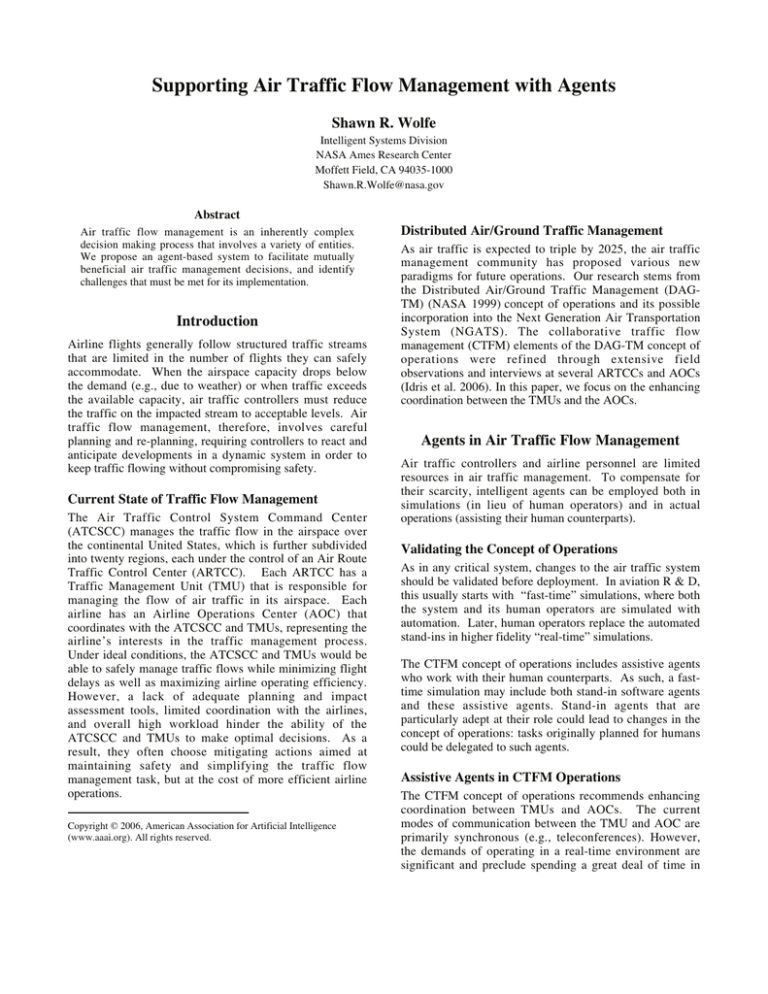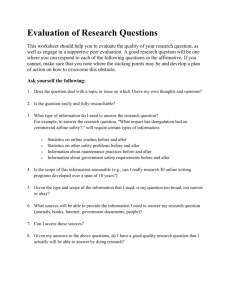
Supporting Air Traffic Flow Management with Agents
Shawn R. Wolfe
Intelligent Systems Division
NASA Ames Research Center
Moffett Field, CA 94035-1000
Shawn.R.Wolfe@nasa.gov
Abstract
Air traffic flow management is an inherently complex
decision making process that involves a variety of entities.
We propose an agent-based system to facilitate mutually
beneficial air traffic management decisions, and identify
challenges that must be met for its implementation.
Introduction
Airline flights generally follow structured traffic streams
that are limited in the number of flights they can safely
accommodate. When the airspace capacity drops below
the demand (e.g., due to weather) or when traffic exceeds
the available capacity, air traffic controllers must reduce
the traffic on the impacted stream to acceptable levels. Air
traffic flow management, therefore, involves careful
planning and re-planning, requiring controllers to react and
anticipate developments in a dynamic system in order to
keep traffic flowing without compromising safety.
Current State of Traffic Flow Management
The Air Traffic Control System Command Center
(ATCSCC) manages the traffic flow in the airspace over
the continental United States, which is further subdivided
into twenty regions, each under the control of an Air Route
Traffic Control Center (ARTCC). Each ARTCC has a
Traffic Management Unit (TMU) that is responsible for
managing the flow of air traffic in its airspace. Each
airline has an Airline Operations Center (AOC) that
coordinates with the ATCSCC and TMUs, representing the
airline’s interests in the traffic management process.
Under ideal conditions, the ATCSCC and TMUs would be
able to safely manage traffic flows while minimizing flight
delays as well as maximizing airline operating efficiency.
However, a lack of adequate planning and impact
assessment tools, limited coordination with the airlines,
and overall high workload hinder the ability of the
ATCSCC and TMUs to make optimal decisions. As a
result, they often choose mitigating actions aimed at
maintaining safety and simplifying the traffic flow
management task, but at the cost of more efficient airline
operations.
Copyright © 2006, American Association for Artificial Intelligence
(www.aaai.org). All rights reserved.
Distributed Air/Ground Traffic Management
As air traffic is expected to triple by 2025, the air traffic
management community has proposed various new
paradigms for future operations. Our research stems from
the Distributed Air/Ground Traffic Management (DAGTM) (NASA 1999) concept of operations and its possible
incorporation into the Next Generation Air Transportation
System (NGATS). The collaborative traffic flow
management (CTFM) elements of the DAG-TM concept of
operations were refined through extensive field
observations and interviews at several ARTCCs and AOCs
(Idris et al. 2006). In this paper, we focus on the enhancing
coordination between the TMUs and the AOCs.
Agents in Air Traffic Flow Management
Air traffic controllers and airline personnel are limited
resources in air traffic management. To compensate for
their scarcity, intelligent agents can be employed both in
simulations (in lieu of human operators) and in actual
operations (assisting their human counterparts).
Validating the Concept of Operations
As in any critical system, changes to the air traffic system
should be validated before deployment. In aviation R & D,
this usually starts with “fast-time” simulations, where both
the system and its human operators are simulated with
automation. Later, human operators replace the automated
stand-ins in higher fidelity “real-time” simulations.
The CTFM concept of operations includes assistive agents
who work with their human counterparts. As such, a fasttime simulation may include both stand-in software agents
and these assistive agents. Stand-in agents that are
particularly adept at their role could lead to changes in the
concept of operations: tasks originally planned for humans
could be delegated to such agents.
Assistive Agents in CTFM Operations
The CTFM concept of operations recommends enhancing
coordination between TMUs and AOCs. The current
modes of communication between the TMU and AOC are
primarily synchronous (e.g., teleconferences). However,
the demands of operating in a real-time environment are
significant and preclude spending a great deal of time in
communications, resulting in a loss of efficiency.
Assistive agents can handle portions of this communication
process, enabling less intrusive, asynchronous forms of
communication or even automating some negotiations
entirely. Agents can broadcast information (e.g., airspace
demand, impact assessments, scheduling decisions) to
cooperating parties, distilling and presenting information to
the user. They can act as a proxy for the user, presenting
policy or preference information, or take their place in
negotiation. Finally, when appropriate, they can assist the
user in decision-making, or be granted the authority to
make certain decisions without human involvement.
Research Issues
Agents show great potential to facilitate more efficient air
traffic management, but a variety of challenges must be
met for their successful deployment.
Supporting Communication
Our primary focus is to facilitate better coordination
between the TMU and the AOC through more effective
communication. Time constraints prevent the human users
from addressing this themselves; agents do not face the
same restrictions, but present different challenges.
Modeling Users and Preferences. A comprehensive
understanding of the involved entities, both organizations
and individuals, will be required to create effective
assistive agents and accurate fast-time simulations. The
representation should be easily understood yet powerful
enough to capture business models, environmental
constraints and user intents.
Are the processes and
relevant human behavior understood well enough to be
emulated by agents in the fast-time simulation?
Effective Communication Modes. The alternative forms
of communication must be carefully considered for each
information transaction. Under what circumstances is a
static policy (i.e., preferences) sufficient? How and when
is it appropriate to notify or interrupt a user?
Information Integration, Translation & Interpretation.
A user’s agent must be able to combine, refine, and filter
communicated information in order to reduce the user’s
cognitive overhead. This requires an understanding and
mediation of the different languages used by the various
entities involved – concepts used by one agent will relate
but not exactly match that of another; different parties may
use different terminology and approach traffic management
differently. The agent must use reasoning to re-express
information in terms that are best understood by the user.
Delegation and Shared Control
Field observations indicated that TMU workload inhibited
the communication needed for optimal decisions. Agents
can reduce this workload by sharing the task burden.
Full Autonomy.
Any task that can be completely
automated offers the greatest gain to the offloaded user, but
care must be taken when automating critical actions. What
tasks can the agent perform independently without
jeopardizing safety, and how can this be demonstrated?
Mixed Initiative. Other tasks may be completed by the
user alone, the agent alone, or jointly. Though often safer
than pure autonomy, shared activities have other control
issues. Cooperation is more complex than independent
activity and the agent must not counteract user actions.
Knowledge Acquisition
Implementing and adapting a system of agents for air
traffic management will be knowledge intensive. Some of
this knowledge can be elicited from experts, but this is not
always practical, and some knowledge is difficult even for
experts to articulate or realize.
Learning from Historical Data. When available,
historical data can serve as a basis for developing models
of human behavior, either manually or through machine
learning methods. Environmental conditions and inputs
from other persons form the attribute space, from which
the correct decision could be learned.
Adapting to Changing Conditions. Just as learning can
be used to set up the initial model, it can also be used by
the agent to adapt to the simulation. This gives the agent
the ability to both adapt to situations different than in the
historical data as well as to correct errors in its model.
Conclusion
Today’s air traffic management system is a high-stakes,
complex system that has maintained a remarkable safety
record. Part of this safety record has come at the cost of
increased operating efficiency, a trend that is expected to
increase in the future. Assistive agents can help reverse
this trend by supporting better communication between
collaborating parties, thus leading to improved decisions.
However, several technical obstacles must be overcome for
such agents to be effective: supporting minimal and
effective communication; sharing control; and building and
refining models based on historical data and experience.
Acknowledgements
We would like to thank Karl Bilimoria and Richard Keller.
References
Idris, H., Evans, A., Vivona, R., Krozel, J., and Bilimoria,
K., 2006. Field Observations of Interactions between
Traffic Flow Management and Airline Operations. In
Proceedings of the AIAA 6th Aviation, Technology,
Integration, and Operations Conference (ATIO), Wichita,
Kansas.
NASA, 1999. Concept Definition for Distributed
Air/Ground Traffic Management (DAG-TM). v1.0. NASA
Ames Research Center, Moffett Field.


